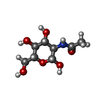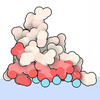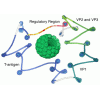+ Open data
Open data
- Basic information
Basic information
| Entry | Database: PDB / ID: 9bur | ||||||
|---|---|---|---|---|---|---|---|
| Title | Structure of GGCX-BGP complex | ||||||
 Components Components |
| ||||||
 Keywords Keywords | MEMBRANE PROTEIN / LYASE/SUBSTRATE / vitamin K cycle / LYASE-SUBSTRATE complex | ||||||
| Function / homology |  Function and homology information Function and homology informationresponse to hydroxyisoflavone / hydroxyapatite binding / structural constituent of bone / peptidyl-glutamate 4-carboxylase / gamma-glutamyl carboxylase activity / negative regulation of testosterone biosynthetic process / cellular response to zinc ion starvation / negative regulation of bone development / response to macrophage colony-stimulating factor / Defective gamma-carboxylation of F9 ...response to hydroxyisoflavone / hydroxyapatite binding / structural constituent of bone / peptidyl-glutamate 4-carboxylase / gamma-glutamyl carboxylase activity / negative regulation of testosterone biosynthetic process / cellular response to zinc ion starvation / negative regulation of bone development / response to macrophage colony-stimulating factor / Defective gamma-carboxylation of F9 / vitamin binding / vitamin K metabolic process / regulation of testosterone biosynthetic process / response to vitamin K / negative regulation of neurotransmitter secretion / regulation of osteoclast differentiation / cellular response to vitamin D / regulation of bone mineralization / type B pancreatic cell proliferation / regulation of bone resorption / osteoblast development / response to vitamin D / response to zinc ion / positive regulation of neurotransmitter secretion / response to testosterone / response to gravity / bone mineralization / RUNX2 regulates osteoblast differentiation / response to mechanical stimulus / Transport of gamma-carboxylated protein precursors from the endoplasmic reticulum to the Golgi apparatus / Gamma-carboxylation of protein precursors / Removal of aminoterminal propeptides from gamma-carboxylated proteins / regulation of cellular response to insulin stimulus / response to glucocorticoid / protein maturation / response to activity / skeletal system development / stem cell differentiation / hormone activity / bone development / brain development / protein modification process / cellular response to growth factor stimulus / Golgi lumen / response to estrogen / cognition / cellular response to insulin stimulus / blood coagulation / osteoblast differentiation / glucose homeostasis / response to ethanol / perikaryon / vesicle / learning or memory / cell adhesion / response to xenobiotic stimulus / endoplasmic reticulum lumen / calcium ion binding / dendrite / endoplasmic reticulum membrane / structural molecule activity / extracellular space / extracellular region / membrane / cytoplasm Similarity search - Function | ||||||
| Biological species |  Homo sapiens (human) Homo sapiens (human) | ||||||
| Method | ELECTRON MICROSCOPY / single particle reconstruction / cryo EM / Resolution: 2.95 Å | ||||||
 Authors Authors | Wang, R. / Qi, X. | ||||||
| Funding support |  United States, 1items United States, 1items
| ||||||
 Citation Citation |  Journal: Nature / Year: 2025 Journal: Nature / Year: 2025Title: Structure and mechanism of vitamin-K-dependent γ-glutamyl carboxylase. Authors: Rong Wang / Baozhi Chen / Nadia Elghobashi-Meinhardt / Jian-Ke Tie / Alyssa Ayala / Ning Zhou / Xiaofeng Qi /   Abstract: γ-Glutamyl carboxylase (GGCX) is the sole identified enzyme that uses vitamin K (VK) as a cofactor in humans. This protein catalyses the oxidation of VK hydroquinone to convert specific glutamate ...γ-Glutamyl carboxylase (GGCX) is the sole identified enzyme that uses vitamin K (VK) as a cofactor in humans. This protein catalyses the oxidation of VK hydroquinone to convert specific glutamate residues to γ-carboxyglutamate residues in VK-dependent proteins (VDPs), which are involved in various essential biological processes and diseases. However, the working mechanism of GGCX remains unclear. Here we report three cryogenic electron microscopy structures of human GGCX: in the apo state, bound to osteocalcin (a VDP) and bound to VK. The propeptide of the VDP binds to the lumenal domain of GGCX, which stabilizes transmembrane helices 6 and 7 of GGCX to create the VK-binding pocket. After binding of VK, residue Lys218 in GGCX mediates the oxidation of VK hydroxyquinone, which leads to the deprotonation of glutamate residues and the construction of γ-carboxyglutamate residues. Our structural observations and results from binding and cell biological assays and molecular dynamics simulations show that a cholesterol molecule interacts with the transmembrane helices of GGCX to regulate its protein levels in cells. Together, these results establish a link between cholesterol metabolism and VK-dependent pathways. | ||||||
| History |
|
- Structure visualization
Structure visualization
| Structure viewer | Molecule:  Molmil Molmil Jmol/JSmol Jmol/JSmol |
|---|
- Downloads & links
Downloads & links
- Download
Download
| PDBx/mmCIF format |  9bur.cif.gz 9bur.cif.gz | 146.4 KB | Display |  PDBx/mmCIF format PDBx/mmCIF format |
|---|---|---|---|---|
| PDB format |  pdb9bur.ent.gz pdb9bur.ent.gz | 109.6 KB | Display |  PDB format PDB format |
| PDBx/mmJSON format |  9bur.json.gz 9bur.json.gz | Tree view |  PDBx/mmJSON format PDBx/mmJSON format | |
| Others |  Other downloads Other downloads |
-Validation report
| Arichive directory |  https://data.pdbj.org/pub/pdb/validation_reports/bu/9bur https://data.pdbj.org/pub/pdb/validation_reports/bu/9bur ftp://data.pdbj.org/pub/pdb/validation_reports/bu/9bur ftp://data.pdbj.org/pub/pdb/validation_reports/bu/9bur | HTTPS FTP |
|---|
-Related structure data
| Related structure data |  44917MC  9bumC  9buxC C: citing same article ( M: map data used to model this data |
|---|---|
| Similar structure data | Similarity search - Function & homology  F&H Search F&H Search |
- Links
Links
- Assembly
Assembly
| Deposited unit | 
|
|---|---|
| 1 |
|
- Components
Components
-Protein , 2 types, 2 molecules AB
| #1: Protein | Mass: 88652.609 Da / Num. of mol.: 1 Source method: isolated from a genetically manipulated source Source: (gene. exp.)  Homo sapiens (human) / Gene: GGCX, GC / Production host: Homo sapiens (human) / Gene: GGCX, GC / Production host:  Homo sapiens (human) Homo sapiens (human)References: UniProt: P38435, peptidyl-glutamate 4-carboxylase |
|---|---|
| #2: Protein | Mass: 11804.439 Da / Num. of mol.: 1 Source method: isolated from a genetically manipulated source Source: (gene. exp.)  Homo sapiens (human) / Gene: BGLAP / Production host: Homo sapiens (human) / Gene: BGLAP / Production host:  Homo sapiens (human) / References: UniProt: P02818 Homo sapiens (human) / References: UniProt: P02818 |
-Sugars , 2 types, 3 molecules 
| #3: Polysaccharide | 2-acetamido-2-deoxy-beta-D-glucopyranose-(1-4)-2-acetamido-2-deoxy-beta-D-glucopyranose Source method: isolated from a genetically manipulated source |
|---|---|
| #4: Sugar |
-Non-polymers , 2 types, 2 molecules 


| #5: Chemical | ChemComp-CLR / |
|---|---|
| #6: Chemical | ChemComp-POV / ( |
-Details
| Has ligand of interest | N |
|---|---|
| Has protein modification | Y |
-Experimental details
-Experiment
| Experiment | Method: ELECTRON MICROSCOPY |
|---|---|
| EM experiment | Aggregation state: PARTICLE / 3D reconstruction method: single particle reconstruction |
- Sample preparation
Sample preparation
| Component | Name: GGCX-BGP complex / Type: COMPLEX / Entity ID: #1-#2 / Source: RECOMBINANT |
|---|---|
| Source (natural) | Organism:  Homo sapiens (human) Homo sapiens (human) |
| Source (recombinant) | Organism:  Homo sapiens (human) Homo sapiens (human) |
| Buffer solution | pH: 7.5 |
| Specimen | Embedding applied: NO / Shadowing applied: NO / Staining applied: NO / Vitrification applied: YES |
| Vitrification | Cryogen name: ETHANE |
- Electron microscopy imaging
Electron microscopy imaging
| Experimental equipment |  Model: Titan Krios / Image courtesy: FEI Company |
|---|---|
| Microscopy | Model: FEI TITAN KRIOS |
| Electron gun | Electron source:  FIELD EMISSION GUN / Accelerating voltage: 300 kV / Illumination mode: FLOOD BEAM FIELD EMISSION GUN / Accelerating voltage: 300 kV / Illumination mode: FLOOD BEAM |
| Electron lens | Mode: BRIGHT FIELD / Nominal defocus max: 2000 nm / Nominal defocus min: 1000 nm |
| Image recording | Electron dose: 60 e/Å2 / Film or detector model: GATAN K3 (6k x 4k) |
- Processing
Processing
| CTF correction | Type: NONE |
|---|---|
| 3D reconstruction | Resolution: 2.95 Å / Resolution method: FSC 0.143 CUT-OFF / Num. of particles: 218162 / Symmetry type: POINT |
 Movie
Movie Controller
Controller





 PDBj
PDBj
















